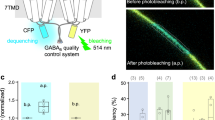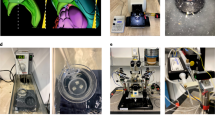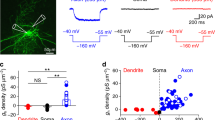Abstract
In the mammalian central nervous system amino acids such as L-glutamate and L-aspartate are thought to act as fast synaptic transmitters1,2. It has been suggested that at least three pharmacologically-distinguishable types of glutamate receptor occur in central neurons and that these are selectively activated by the glutamate analogues N-methyl-D-aspartate (NMDA), quisqualate and kainate3–5. These three receptor types would be expected to open ion channels with different conductances. Hence if agonists produce similar channel conductances this would suggest they are acting on the same receptor6,7. Another possibility is suggested by experiments on spinal neurons8, where GABA (γ-amino butyric acid) and glycine appear to open different sub-conductance levels of one class of channel while acting on different receptors. By analogy, several types of glutamate receptor could also be linked to a single type of channel with several sub-conductance states. We have examined these possibilities in cerebellar neurons by analysing the single-channel currents9 activated by L-glutamate, L-aspartate, NMDA, quisqualate and kainate in excised membrane patches. All of these agonists are capable of opening channels with at least five different conductance levels, the largest being about 45–50 pS. NMDA predominantly activated conductance levels above 30 pS while quisqualate and kainate mainly activated ones below 20 pS. The presence of clear transitions between levels favours the idea that the five main levels are all sub-states of the same type of channel.
This is a preview of subscription content, access via your institution
Access options
Subscribe to this journal
Receive 51 print issues and online access
$199.00 per year
only $3.90 per issue
Buy this article
- Purchase on Springer Link
- Instant access to full article PDF
Prices may be subject to local taxes which are calculated during checkout
Similar content being viewed by others
References
Curtis, D. R. & Johnston, G. A. R. Ergebn. Physiol. 69, 97–188 (1974).
Krnjevic, K. Physiol. Rev. 54, 418–540 (1974).
Watkins, J. C. & Evans, R. H. A. Rev. Pharmac. Toxicol. 21, 165–204 (1981).
Foster, A. C. & Fagg, G. E. Brain Res. Rev. 7, 103–164 (1984).
Mayer, M. L. & Westbrook, G. L. J. Physiol., Lond. 384, 29–53 (1984).
Cull-Candy, S. G., Miledi, R. & Parker, I. J. Physiol., Lond. 321, 195–210 (1981).
Gardner, P., Ogden, D. C. & Colquhoun, D. Nature 309, 160–162 (1984).
Hamill, O. P., Bormann, J. & Sakmann, B. Nature 305, 805–808 (1983).
Hamill, O. P., Marty, A., Neher, E., Sakmann, B. & Sigworth, F. J. Pflügers Arch. ges. Physiol. 391, 85–100 (1981).
Moonen, G., Neale, E. A., Macdonald, R. L., Warren, G. & Nelson, P. G. Devl Brain Res. 5, 59–73 (1982).
Weber, A. & Schachner, M. Brain Res. 311, 119–130 (1984).
Gruol, D. L. Brain Res. 263, 223–241 (1983).
Cull-Candy, S. G. & Usowicz, M. M. Brain Res. (in the press).
Crepel, F., Dupont, J.-L. & Gardette, R. Brain Res. 279, 311–315 (1983).
Nowak, L., Bregestovski, P., Ascher, P., Herbet, A. & Prochiantz, A. Nature 307, 462–465 (1984).
Cull-Candy, S. G. & Ogden, D. C. Proc. R. Soc. B224, 367–373 (1985).
Katz, B. & Miledi, R. J. Physiol., Lond. 224, 665–699 (1972).
Anderson, C. R. & Stevens, C. F. J. Physiol., Lond. 235, 655–691 (1973).
Ascher, P., Nowak, L. & Kehoe, J. S. in Ion Channels in Neural Membranes (eds Ritchie, J. M., Keynes, R. D. & Bolis, L.) 823–295 (Liss, New York, 1986).
Ishida, A. T. & Neyton, J. Proc. natn. Acad. Sci. U.S.A. 82, 1837–1841 (1985).
Hamill, O. P. & Sakmann, B. Nature 294, 462–464 (1981).
Trautmann, A. Nature 298, 272–275 (1982).
Läuger, P. Biophys. J. 47, 581–590 (1985).
MacDermott, A. B., Mayer, M. L., Westbrook, G. L., Smith, S. J. & Barker, J. L. Nature 321, 519–522 (1986).
Ascher, P. & Nowak, L. J. Physiol., Lond. 377, 35P (1986).
Mayer, M. L., Westbrook, G. L. & Guthrie, P. B. Nature 309, 261–263 (1984).
Colquhoun, D. & Sigworth, F. J. in Single Channel Recording (eds Sakmann, B. & Neher, E.) 191–264 (Plenum, New York, 1983).
Cull-Candy, S. G. & Ogden, D. C. in Ion Channels in Neural Membranes (eds Ritchie, J. M., Keynes, R. D. & Bolis, L.) 297–308 (Liss, New York, 1986).
Author information
Authors and Affiliations
Rights and permissions
About this article
Cite this article
Cull-Candy, S., Usowicz, M. Multiple-conductance channels activated by excitatory amino acids in cerebellar neurons. Nature 325, 525–528 (1987). https://doi.org/10.1038/325525a0
Received:
Accepted:
Issue Date:
DOI: https://doi.org/10.1038/325525a0
This article is cited by
-
AMPA-Type Glutamate Receptor Conductance Changes and Plasticity: Still a Lot of Noise
Neurochemical Research (2019)
-
NMDA receptor permeation: a light in the tunnel
Nature Neuroscience (2012)
-
Remote Modulation of Current Transfer from Dendritic Glutamatergic Synapses by GABA-ergic Synapses of the Somatic Zone of Motoneurons: a Simulation Study
Neurophysiology (2010)
-
Comparative virtual screening and novelty detection for NMDA-GlycineB antagonists
Journal of Computer-Aided Molecular Design (2009)
-
Agonist‐activated ion channels
British Journal of Pharmacology (2006)
Comments
By submitting a comment you agree to abide by our Terms and Community Guidelines. If you find something abusive or that does not comply with our terms or guidelines please flag it as inappropriate.



